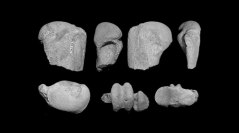

 Comptes Rendus Palevol
13 (7) - Pages 555-560
Comptes Rendus Palevol
13 (7) - Pages 555-560A tarsometatarsus and a fragmented humerus of striking dimensions recently collected in the Late Eocene locality DPV 13/84 Submeseta Formation-level 38 Submeseta II-, Seymour (Marambio) Island, Antarctic Peninsula were both assigned to Palaeeudyptes klekowskii. According to estimates, the tarsometatarsus would belong to the largest and most massive penguin described so far. This bird was probably a piscivorous penguin, with high diving ability for catching prey. Although the humerus is not an appropriate element for body mass or body length assessments, it also belonged to a huge penguin.
Giant penguins, Palaeeudyptes klekowskii, Eocene, Antarctica, Submeseta Formation